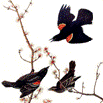Wildlife Damage Management, Internet Center for
Document Type
Article
Date of this Version
September 1966
Abstract
Histoplasmosis is a disease affecting man and many other ani¬mals including the dog, cat, cow, horse, and several wild animals. It is caused by a pathogenic fungus known as Histoplasma capsulatum. This fungus lives and multiplies in the ground as a mold. It prefers the undisturbed litter in and around old chicken houses or in undis¬turbed droppings under bird roosts. It has been found in the soil of dog kennels, under porches of old houses, under trees and bushes frequented by birds in the daytime. It has also been found in isolated caves and hollow trees. It apparently is capable of competing very well with other organisms found in the ground if the ground is en¬riched by fecal material of chickens, other birds or bats. It is quite significant that histoplasmosis is not found in chickens or in fresh chicken droppings. Work done by Menges (Menges et al., 1955) in Kansas City indicates that chickens and probably all birds are not susceptible to natural infection. This may be due to their high body temperatures. A chicken's temperature is about 106°F. Other birds range from 104° to 110°F. Histoplasmosis is a very common disease today in many parts of the world. We have had more than our own share of it in Missouri. This is probably due partly to the vast research program carried on by the Communicable Disease Center in Kansas City. For example, in Boone County, a survey of all rural school children in 1952 revealed that 84% of the children were positive to the skin test by the time they were seven years of age. When Dr. Samuel T. Darling reported the first three cases oc¬curring between 1904-1906 and called the disease histoplasmosis, he believed that all cases ended in death because it was only observed on postmortem. This belief continued until 1934 when the fungus was cultured and animals experimentally infected. In 1949, the organism was first isolated from soil by C. W. Emmons. Since that time thou¬sands of soil samples have been found to contain this fungus.


